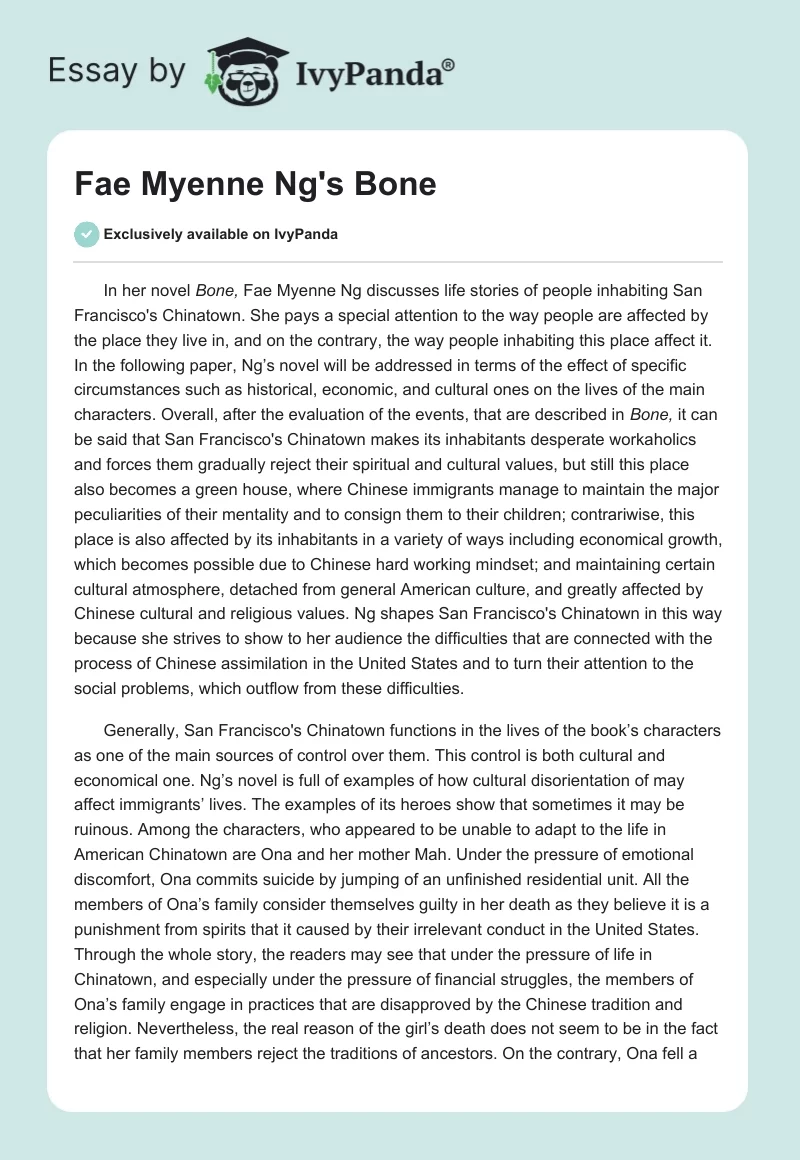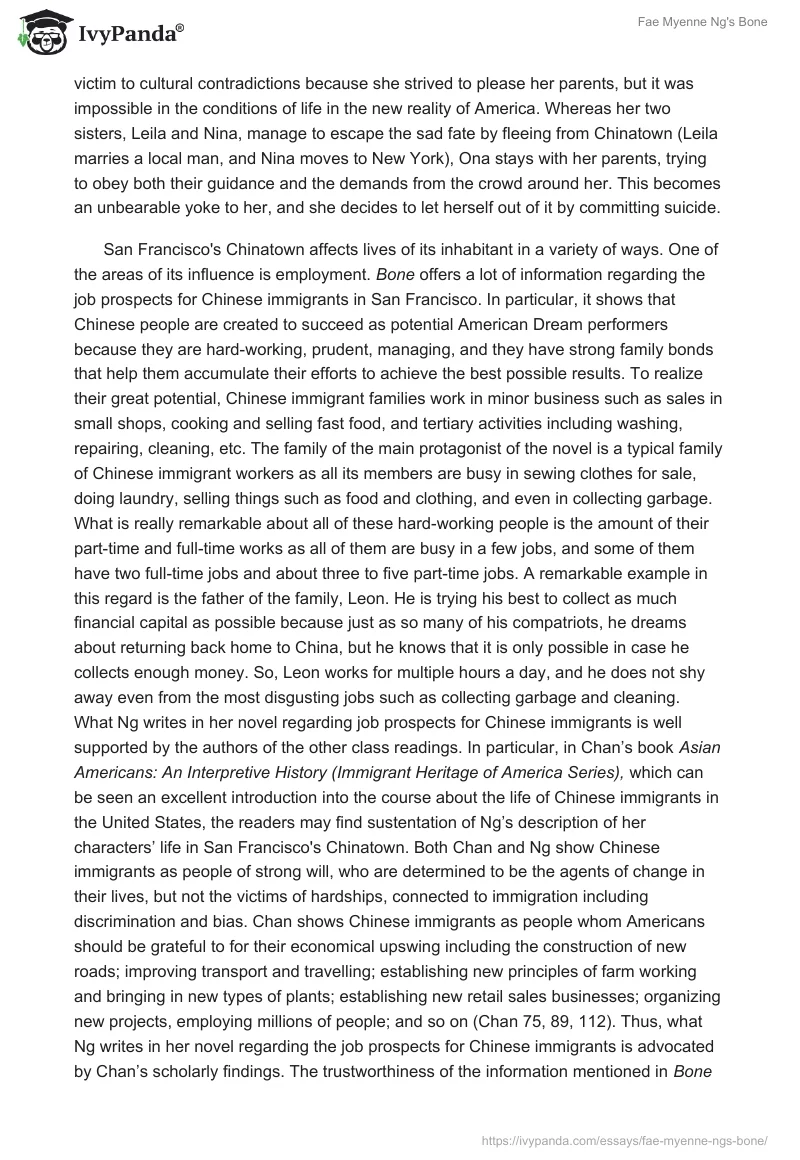In her novel Bone, Fae Myenne Ng discusses life stories of people inhabiting San Francisco’s Chinatown. She pays a special attention to the way people are affected by the place they live in, and on the contrary, the way people inhabiting this place affect it. In the following paper, Ng’s novel will be addressed in terms of the effect of specific circumstances such as historical, economic, and cultural ones on the lives of the main characters. Overall, after the evaluation of the events, that are described in Bone, it can be said that San Francisco’s Chinatown makes its inhabitants desperate workaholics and forces them gradually reject their spiritual and cultural values, but still this place also becomes a green house, where Chinese immigrants manage to maintain the major peculiarities of their mentality and to consign them to their children; contrariwise, this place is also affected by its inhabitants in a variety of ways including economical growth, which becomes possible due to Chinese hard working mindset; and maintaining certain cultural atmosphere, detached from general American culture, and greatly affected by Chinese cultural and religious values. Ng shapes San Francisco’s Chinatown in this way because she strives to show to her audience the difficulties that are connected with the process of Chinese assimilation in the United States and to turn their attention to the social problems, which outflow from these difficulties.
Generally, San Francisco’s Chinatown functions in the lives of the book’s characters as one of the main sources of control over them. This control is both cultural and economical one. Ng’s novel is full of examples of how cultural disorientation of may affect immigrants’ lives. The examples of its heroes show that sometimes it may be ruinous. Among the characters, who appeared to be unable to adapt to the life in American Chinatown are Ona and her mother Mah. Under the pressure of emotional discomfort, Ona commits suicide by jumping of an unfinished residential unit. All the members of Ona’s family consider themselves guilty in her death as they believe it is a punishment from spirits that it caused by their irrelevant conduct in the United States. Through the whole story, the readers may see that under the pressure of life in Chinatown, and especially under the pressure of financial struggles, the members of Ona’s family engage in practices that are disapproved by the Chinese tradition and religion. Nevertheless, the real reason of the girl’s death does not seem to be in the fact that her family members reject the traditions of ancestors. On the contrary, Ona fell a victim to cultural contradictions because she strived to please her parents, but it was impossible in the conditions of life in the new reality of America. Whereas her two sisters, Leila and Nina, manage to escape the sad fate by fleeing from Chinatown (Leila marries a local man, and Nina moves to New York), Ona stays with her parents, trying to obey both their guidance and the demands from the crowd around her. This becomes an unbearable yoke to her, and she decides to let herself out of it by committing suicide.
San Francisco’s Chinatown affects lives of its inhabitant in a variety of ways. One of the areas of its influence is employment. Bone offers a lot of information regarding the job prospects for Chinese immigrants in San Francisco. In particular, it shows that Chinese people are created to succeed as potential American Dream performers because they are hard-working, prudent, managing, and they have strong family bonds that help them accumulate their efforts to achieve the best possible results. To realize their great potential, Chinese immigrant families work in minor business such as sales in small shops, cooking and selling fast food, and tertiary activities including washing, repairing, cleaning, etc. The family of the main protagonist of the novel is a typical family of Chinese immigrant workers as all its members are busy in sewing clothes for sale, doing laundry, selling things such as food and clothing, and even in collecting garbage. What is really remarkable about all of these hard-working people is the amount of their part-time and full-time works as all of them are busy in a few jobs, and some of them have two full-time jobs and about three to five part-time jobs. A remarkable example in this regard is the father of the family, Leon. He is trying his best to collect as much financial capital as possible because just as so many of his compatriots, he dreams about returning back home to China, but he knows that it is only possible in case he collects enough money. So, Leon works for multiple hours a day, and he does not shy away even from the most disgusting jobs such as collecting garbage and cleaning. What Ng writes in her novel regarding job prospects for Chinese immigrants is well supported by the authors of the other class readings. In particular, in Chan’s book Asian Americans: An Interpretive History (Immigrant Heritage of America Series), which can be seen an excellent introduction into the course about the life of Chinese immigrants in the United States, the readers may find sustentation of Ng’s description of her characters’ life in San Francisco’s Chinatown. Both Chan and Ng show Chinese immigrants as people of strong will, who are determined to be the agents of change in their lives, but not the victims of hardships, connected to immigration including discrimination and bias. Chan shows Chinese immigrants as people whom Americans should be grateful to for their economical upswing including the construction of new roads; improving transport and travelling; establishing new principles of farm working and bringing in new types of plants; establishing new retail sales businesses; organizing new projects, employing millions of people; and so on (Chan 75, 89, 112). Thus, what Ng writes in her novel regarding the job prospects for Chinese immigrants is advocated by Chan’s scholarly findings. The trustworthiness of the information mentioned in Bone regarding job prospects for Chinese immigrants in San Francisco’s Chinatown is also proved by Maxwell’s findings in her article “Chinese Experience In North America”. In this article, the writer shows that Chinese ‘workaholic mentality’ opens many doors for employment in the United States. As Native Americans are not attracted by tertiary activity businesses, these fields are traditionally occupied by Chinese immigrants (Maxwell 17). Besides, according to Maxwell, Chinese people are usually effective in retail business (Maxwell 17). In Ng’s text, we find the examples of how these tendencies are realized by Leon’s family in practice. For instance, Leon, his wife and his daughters engage in laundry business; Leon regularly makes money by selling different goods; Mah manages to open her own shop selling clothes, etc. Ngai also supports the information regarding economical backgrounds of Chinese people’s life in the United States by explaining that even beginning from the years of the Cold War, they were actively occupied in a variety of minor businesses in the United States, which helped the economy of the country make a great progress in the 1960s and in the 1970s (Ngai 10). Reflecting on scholarly accounts in regard to the lives of Chinese immigrants in the United States, Leon’s words come on mind, “life was work” (Ng 178). Truly, in Ng’s novel and in the other course readings, it is evident that the whole essence of life for immigrant Chinese was in work and acquiring a better financial status.
The other area that is greatly affected by San Francisco’s Chinatown is family life and moral standards. Analyzing the story plot of the novel, it is possible to see that the inhabitants of San Francisco’s Chinatown are generally highly moral people, who try to defend their spiritual and cultural values even under the pressure of difficult life circumstances in the conditions of the new country. More than anything these people value the bonds of family, and they especially pay tribute to their parents and the other older people in the family. This is seen on the example of Leila, the main protagonist, who values her parents more than everything, and she even decides to stay next to them after her marriage with Mason. Similar attitude to parents can be seen in the case of Leon, and his attitude to his father. The triumph of unconditional obedience and unlimited honor to her parents is seen in the example of Ona. The girl is so devoted to her father and mother that she feels that it is better for her to continue following ancient family traditions to please her parents even if it will be the source of her daily grief. Under the pressure of this grief and the bitter feelings connected with it, she commits suicide because she appears unable to go any further. However, as the reader proceeds through the novel’s development, it becomes possible to notice that some characters relinquish their principles at times, and commit sins that later trouble their conscience. For example, Mah feels ashamed on the reason of her love affair with her American boss, and she even believes that her daughter Ona’s death is a punishment from above for her immorality. Also, Leon thinks that his failure to follow the ancient tradition of burying ancestors at their birth place in China was a mistake that cost his daughter Ona her life because of the anger from above. Leon is courageous enough to break the ancient traditions, but the way he feels shows that his cultural and religious beliefs are still strong in him even though he is in a different land, where there are very different customs and traditions.
In conclusion, it should be stated that the novel Bone by Fae Myenne Ng can be seen as a detailed excurse into the peculiarities of Chinese immigrants’ life in San Francisco’s Chinatown. In particular, the novel shows that this place affects its inhabitants in a variety of ways including their economic perspectives, cultural peculiarities, and supporting their family values. Bone also shows that the place itself is also affected by its inhabitants, which is seen in its economical prosperity and the unique cultural atmosphere that is different from the rest of the country. Ng depicts San Francisco’s Chinatown in this way to turn attention of her readers to the social problems that are connected with the process of Chinese assimilation in the United States.
References
Chan, Sucheng. Asian Americans: An Interpretive History (Immigrant Heritage of America Series), The United States: Twayne Publishers, 1991. Print.
Maxwell, Judy Lam. “Chinese Experience In North America.” Chinese American Forum 26.4 (2011): 15-28. Print.
Ng, Fae Myenne. Bone, New York: Hyperion, 2008. Print.
Ngai, Mae. “Legacies of Exclusion: Illegal Chinese Immigration during the Cold War Years.” Journal of American Ethnic History 18.1 (1998): 3-35. Print.


